Content
How much hay a cow needs for the winter depends on its quality, the type of grass cut and the animal's appetite. All living organisms have a different metabolism, and the need for food is also different. Roughage can be nutritious or "empty". The amount of food that a particular animal needs, each owner will have to set independently. But there are averages that can be taken as a starting point.
Types of hay for cattle
The division of roughage into species now occurs almost on an arbitrary basis. Traditionally, they were divided according to the composition of the herbs. Now you can find the division according to the level of moisture or nutritional value. Which method to choose when dividing hay into species depends on current priorities.
The composition of the hay can be forbs or sowing. These two groups are divided into smaller categories. Forbs are “wild” herbs. It can be:
- Mountainous, collected in the area of the belt of alpine meadows. It is considered one of the best.
- From flooded meadows, floodplains of rivers that are flooded in high water.
- Forest, collected from the edges of the forest.
- Swamp, harvested in very humid places.
The latter is considered the least nutritious. Moreover, such hay often contains poisonous horsetail.
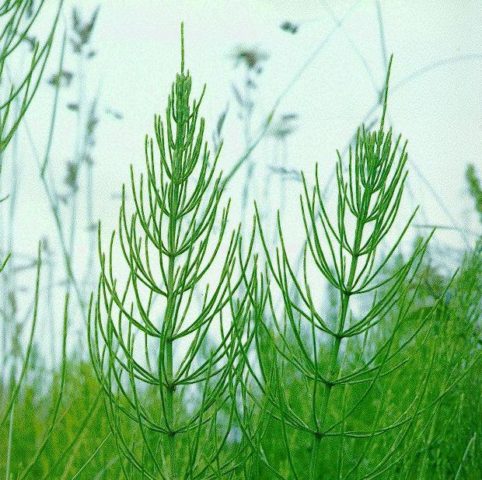
Horsetail is found throughout wild herbs, but prefers moist soil
Sowing can be:
- legumes;
- cereal;
- legume-cereal;
- herbs from specially selected plants.
The latter is optimal in terms of composition and nutritional value.
When buying roughage, you need to pay attention to moisture. Underdried hay will rot, overdried hay crumbles heavily. The owner will lose a lot when the dust falls on the floor and gets dusty. Division of hay by moisture:
- Dry, humidity 15%. It is tough to the touch, cracks and breaks easily when compressed.
- Normal, 17% moisture. Soft, rustles when compressed. When twisted into a bundle, it can withstand 20-30 turns.
- Wet, 18-20%. Soft, easily rolls up into a tourniquet and withstands repeated twisting. There is no sound when compressed. When you try it with your hand, you can feel the coolness inside the roll.
- Raw, moisture content 22-27%. If it is twisted strongly, liquid is released.
The last two categories cannot be stored for the winter. The only exception is haylage harvested using a special technology. But this type requires sealed packaging. Animals should eat the printed roll in 1-2 days.
For the winter, you need to store the first two categories. And best of all is hay with a moisture content of 17%. It should also be borne in mind that the moisture characteristics are also average. "Stick" hay with large lignified stems of plants bursts even at above average humidity. And small-stemmed and consisting of leaves "does not sound" even at humidity below 15%. The same applies to fracture toughness. Large, hard stems break more easily than thin and soft stems.
Another division into categories is produced by nutritional value. The calculation is made in feed units that contain 1 kg of hay:
- meadow herbs 0.45 forage. units;
- legume - 0.5.
The nutritional value of cereal hay depends on the time it was harvested. If the stems are cut after the grain has ripened, this is already straw with a low nutritional value. But cereal grasses cut during the milky ripeness period are considered one of the best types of hay.In addition, you should always take into account the content of calcium, phosphorus, protein and other elements in roughage.
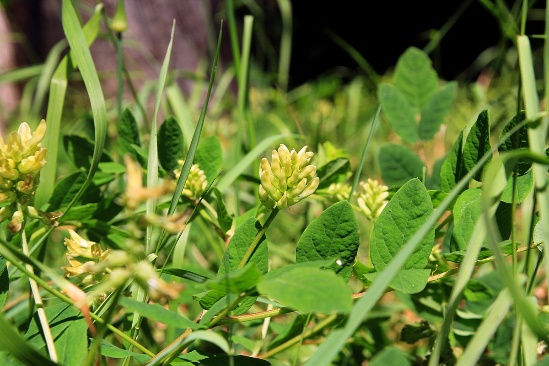
Legumes are considered one of the most nutritious foods, but they can ferment in the stomach.
Herbs
Can be wild-growing and sowing. The first is harvested by simply mowing free meadows and glades. For the second, specially selected varieties of herbs are sown in the field. But you should not count on the purchase of sowing herbs. If they do this, then for their own needs. It is easier to plant a monoculture for sale, which is easier to handle and protect from pests.
Plus "wild" herbs in a large species composition, providing a full set of vitamins. But he is also a minus, since no one can tell which herbs prevail in such hay. Often poisonous plants are found in it. A cow can eat some of them in small quantities, while the poison from others accumulates gradually, but is not excreted from the body.
Nutritional value and mineral composition can also vary greatly. 0.46 feed units - a very average rating. "Alpijskoe" has a high nutritional value and a rich vitamin and mineral composition. Its opposite, boggy, is poor in vitamins and minerals. The nutritional value is also much below average. Reeds, reeds and horsetails are plants that need to be fed only in a desperate situation. The cow herself will not eat them if she has a choice. And this greatly increases the real consumption of hay in winter.
Sowing herbs
If the owner is puzzled by sowing herbs for the winter, seeds are usually used for this:
- timothy;
- multiflorous chaff;
- ryegrass;
- common hedgehogs;
- bluegrass.
Preference is given to those plant species that are adapted to the climatic conditions of the region. In the south, these herbs may also include wild barley. They don't plant him, he grows himself. Its presence in hay is undesirable, since wild barley seeds can cause stomatitis.
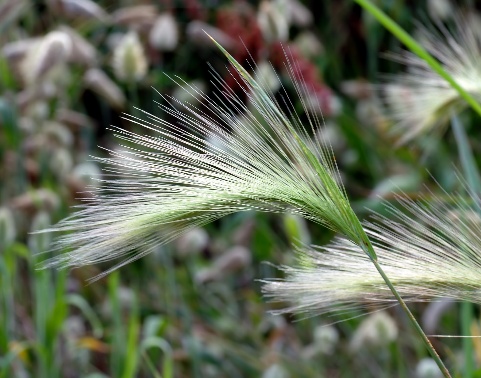
In the southern regions, wild barley is reasonably considered a malicious weed; it is suitable for feed for cows only before the appearance of ears
Zlakovoe
Grain hay is usually planted with oats. It grows well even in poor soils. But it is necessary to mow oats in the degree of "milk maturity" of the grains. If you remove the cereal later, the stalks will turn into poorly nutritious and tasteless straw. Hay made from still green oats is one of the most nutritious varieties.
In addition to oats, herbs related to bluegrass are planted: wheatgrass, fescue, fire, it is also rump, Sudanese grass, millet, timothy grass, and other types of bluegrass.
Almost all of these plants in their mature state are of little nutritional value. When harvesting for the winter, they need to be mowed immediately after flowering or during it.
Bean
This type of hay is considered the most nutritious, as it contains a large percentage of protein. But the fields are usually sown with monocultures. The exception is legume-cereal hay, which consists of a mixture of oats and peas. In other cases, it is more profitable to sow one type of annual or perennial grasses.
Due to the scarcity of the composition, the legume hay is not balanced in terms of nutrients and the cow's diet in winter needs to be adjusted with vitamin and mineral premixes. For the preparation of this type of roughage, vetch, sweet clover, peas, sainfoin, various types of alfalfa, and clover are used.
All these herbs need to be mown during the bud formation period. An exception is clover. Here, clover straw is often used in livestock feed, which remains after threshing the plant for seeds. This straw is rough to the touch, but contains enough protein and calcium to replace hay.

Wild alfalfa is usually not cultivated on purpose, but it is often found in meadow grasses.
How to calculate how much hay a cow needs
The daily hay requirement for a cow depends on:
- the weight of the animal;
- type of hay;
- season of the year;
- quality of feed.
It is not difficult to calculate how many kilograms of hay per day you need per cow. But then the annual exciting "quest" begins, which is called "find out how much hay you need to buy for the winter."
The cow should receive the same amount of nutrients and vitamins that are found in high-quality, completely consumed hay. Such an ideal is almost unattainable. For some reason, many procurers believe that cattle will crush even logs. As a result, hay can be "sticky" - very coarse, thick stems of overripe plants. Cut grass once caught in the rain - minus half of the vitamins. Overdried under the sun - the nutritional value of the hay has decreased.
Underdried, rolled grass begins to "burn" inside. If a lot of moisture remains in the hay, the bale begins to rot from the inside or "dust" by the middle of winter. And this "dust" is actually mold spores. Such hay is poisonous in large quantities, and it has to be washed, along the way to remove vitamins.
If the hay has a low nutritional value, the cow eats more hay. If the food is "stick", there will be a lot of waste, but this does not mean that the animal is full. On the contrary, it remained hungry and did not receive the required amount of nutrients. In legumes, there is a lot of protein and during the dry period it is better not to overuse them.
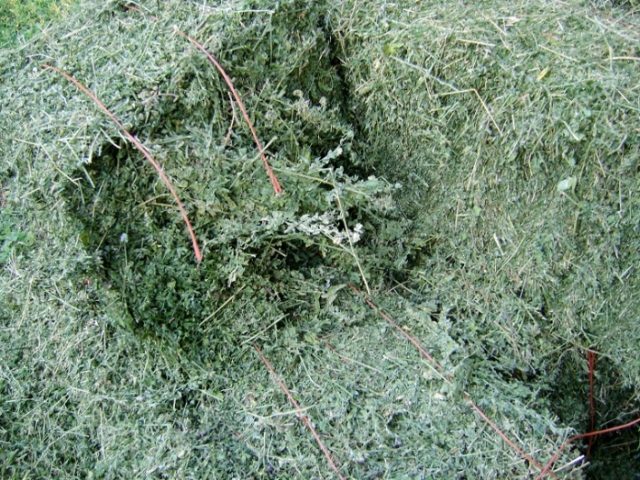
Quality alfalfa that seldom sells
Rules for calculating hay for 1 head of cattle
It is not difficult to calculate the norm by weight. The average weight of an adult cow is usually 500 kg. Bulls can reach 900 kg or more. Animals can be weighed on a special livestock scale. If this is not possible, the live weight of the cow is calculated using the formula: multiply the chest girth by the oblique length of the body, divide by 100 and multiply the result by K.
K is a floating factor. For dairy breeds, its value is 2, for beef cattle - 2.5.
The formula is intended for adult animals that have completed skeletal development.
The average rate of hay per dairy cow is 4 kilograms for every 100 kg of live weight. In the dry period, the rate is increased by reducing concentrates and succulent feed. During lactation, they return to the previous level, since hay has little effect on the amount of milk, but allows the animal to receive the necessary minerals and vitamins.
Bulls have the same hay requirement as dairy cows. During the breeding period, producers increase the percentage of protein in the diet. This is often achieved by adding meat, blood or meat and bone meal as an additive.
For meat breeds, the norm is the same as for dairy breeds. For fattening gobies, you can reduce the amount of roughage to 3 kg, but then you need to increase the concentrates.
But, given that the quality and varieties of hay, as well as the metabolism of animals, are often very different, the norms are determined empirically. Taking the average standards as a basis, they look at how the animal reacts. If it tries to gnaw trees and eats sawdust, the rate of hay should be increased. If it gets fat, remove the concentrates.
Per day
A 500-kg cow needs to eat 20 kg of hay per day. Cattle grows up to 4-5 years, so young heifers and heifers need less feed. At the same time, it is difficult to calculate with the required accuracy how many "grams" need to be added monthly. And you don't need to do this. Usually heifers weigh 300-450 kg, depending on the breed.
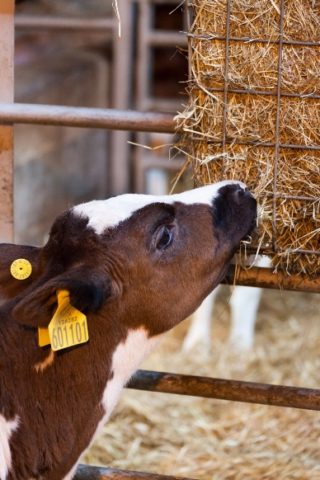
Feed waste can be reduced by making cow feeders
For winter
The estimated amount of hay for the winter depends on the length of the stall period. More precisely, even on how long a cow can find food for itself on grazing. Usually 6 months are taken for the "winter" period. This is also an average figure. In the southern regions, the grass appears earlier, withers later.But in summer there can be a dry period, which is almost no different from winter. The grass will burn out and the cow needs to be fed a full amount of hay again.
In the northern regions, the growing season starts late and ends early. The "winter period" can last more than 7 months. It is necessary to calculate the required amount of hay based on specific conditions.
If we take the average value, then for the winter you need to stock up at least 3650 kg of hay. But it is dangerous to take strictly under the calculation. Losses or late spring are possible. At the end of winter, it is no longer possible to buy hay or its price is very high. You need to take from 4 tons.
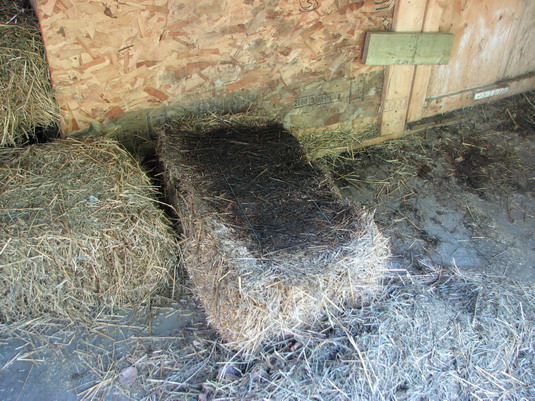
Such a picture can be observed at the end of winter if the bales were not stacked on pallets, but directly on the ground or on a concrete floor.
In year
You can calculate how much hay a cow needs for a year without even using a calculator. It is enough to multiply 365 days by 20. You get 7300 kg or 7.3 tons. In summer, the need for hay is less than in winter, as the cow eats fresh grass. But 10 kg per day will be required. Considering that a lot is likely to be thrown away, this amount may even be small.
Features of feeding cattle with hay in winter
In winter, cows have no grazing, so it is necessary to supplement the “naked” concentrate-hay ration with juicy forages. But it must be borne in mind that a cow can live on roughage, although it will be impossible to get either milk or meat from such an animal. But on some grain and succulent feed cattle are provided with diseases of the digestive tract. Therefore, the basis of the diet in winter is hay.
Bulls can be given roughage 2 times a day: in the morning and in the evening. Heifers and pregnant cows should be given hay 3 times a day. You can split the daily rate into 4 dachas if a quick calving is expected. The fetus in the second half of pregnancy presses on the stomach of the cow, and she cannot eat as much feed at a time as after the birth of the calf.
Even "sticks" are eaten by cows in the form of a chop. Such a fine hay fraction is easier for animals to digest. It can be mixed with compound feed, avoiding tympania due to grain fermentation. Succulent forage is also given along with hay. For the same reason, to avoid fermentation.
Since animals usually choose first which tastes better, then all feed must be mixed with hay. Such a simple trick will "force" the cow to eat all the feed, and not just the tidbits.
Conclusion
How much hay a cow needs for the winter, one way or another, each owner will have to decide for themselves. If stored incorrectly, even 10 tons may not be enough. But you always need to take with a small margin. Even if the hay is of perfect quality and is well stored, the next year may be a bad harvest. Then last year's supplies will help provide the animals with the necessary amount of feed.








